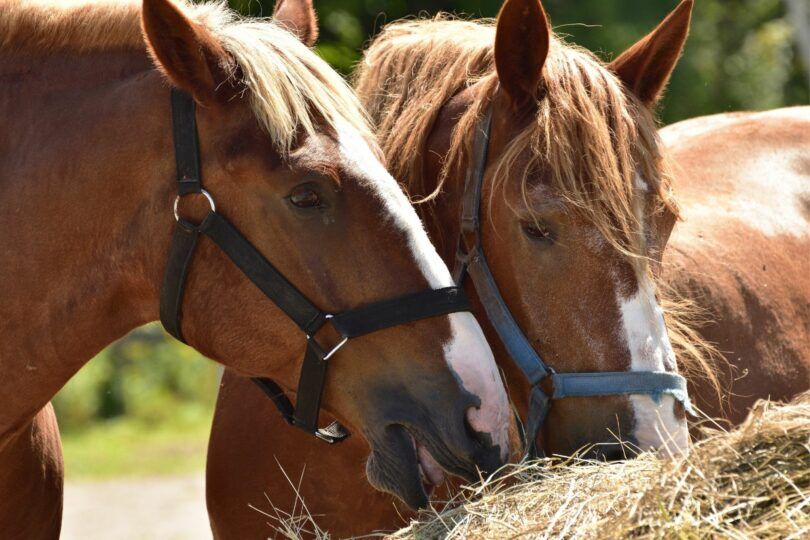Looking for nutrition advice for horses with allergies or metabolic concerns? Soaking hay may be a reasonable solution!
Soaking hay before feeding can achieve two goals: first, reducing the dust content in the hay and second, reducing water-soluble sugar for an overall lower-sugar forage source.
For horses with allergies, soaking for only 10 minutes can significantly reduce the dust content in the hay, making it less irritating. Horses with metabolic concerns may require hay soaked for approximately 60 minutes to bring sugar content down to safer levels.
Soaking hay is an inexpensive way to mitigate two different categories of equine ailments – respiratory and metabolic conditions. This inexpensive method to remove dust and/or sugar is labor-intensive, but produces worthwhile results.
Soaking Hay – The Why
There are at least three reasons a horse owner (or equine caregiver) may want to soak hay before feeding it to horses. Soaking hay can:
- Help remove excess sugars or water-soluble carbohydrates (WSC’s) in the forage. This is important for horses that need a low sugar diet, such as those diagnosed as insulin resistant, those with laminitis, Cushings, or Equine Metabolic Syndrome.
- Mitigate dust and mold in the hay. Dust can be irritating, especially in horses with respiratory conditions, such as allergies. Moldy hay can cause colic, which can be fatal. While you should never feed moldy hay, soaking can remove mold that may otherwise go unseen by the naked eye.
- Make forage more palatable while providing additional hydration.
Source Canva
How Long Do You Soak Hay For?
The recommended length of soaking time depends on the end goal—If you are aiming to reduce dust particles, soaking for only 10 minutes will accomplish this task. To reduce sugar concentration, soaking times may need to be longer. Typically the longer you soak, the more nutrients will be removed. General recommendations range from 30-60 minutes for reduced sugar content.
Soaking To Remove WSC’s
If you have a horse on a low sugar diet, it is recommended to soak hay in cool, clean water for 60 minutes before feeding. Studies have shown that this removes 30-40% of the WSC’s (explained above) present in the hay, without removing other nutrients. While soaking longer does equate to more sugar removed, longer soak times also negatively affect other nutrients available in the hay.
What’s The Easiest Way To Feed Soaked Hay?
The easiest way to feed soaked hay is to put your horse’s hay feeding into a small-hole hay net (while still dry) and submerge it in a large container, such as a plastic tote. You want “abundant” water for maximum results, so don’t try to stuff more than one hay net into each tote.
When you dispose of the water, use caution where you dump it! In the summer months, the hay-soaked water might attract flies, and in the winter it can create dangerous, icy conditions. Always feed hay immediately after soaking to minimize any chances of mold growth.
Soaking Hay vs. Steaming Hay
Steaming hay is a popular practice in the UK, but is still gaining “steam” in the USA. Hay steaming is a bit easier labor-wise than soaking, provided you have the money to invest in a steaming unit—we saw ballpark prices from $1,000-$3,000, so these are definitely an investment!
Steaming will reduce the amount of dust present in the hay while also inactivating molds and mycotoxins. While this is certainly beneficial, steaming is not as effective as soaking at removing sugar from the hay.
Source Canva
Frequently Asked Questions
Q: When should you NOT soak your hay?
Soaking hay removes nutrients. While sugar can be detrimental to horses with metabolic concerns, it is helpful for horses with high caloric needs and no dietary issues to speak of.
Soaking hay in the winter months, with extremely cold temperatures, can also be challenging.
Q: How far in advance can you soak hay?
You should plan to feed hay immediately after soaking to avoid the risk of mold growth. Ingesting mold is toxic to horses; it can cause colic and even death.
Q: How do you transition a horse to eating soaked hay?
Any changes you make to a horse’s diet should be done gradually. Slowly introduce this new forage to minimize the possibility of any issues.
Parting Thoughts
Soaking hay can be beneficial to horses with allergies or metabolic concerns. Be sure to understand your end goal to decide on the appropriate soaking time. While it may take a little effort to get an efficient process set up, this low-cost solution can be a great solution!
P.S. Enjoy this article? Trot on over to:
- Winter Hay 101: How Much to Feed Your Horse (And Why)
- Horse Hay FAQs: List of Types of Hay, What Hay is Best, etc.
- Alfalfa Cubes vs. Pellets: What’s Best for Your Horse?
- Stability & Safety: How to Stack and Store Hay Bales
- Food or Foe: What Do Horses Eat (And Why)
- Hay Bale Facts and Figures (Sizes, Types, Costs)
- Fact of Fiction: Do Horses Eat Meat?
- 9 Best Online Equine Courses (Care, Training, Riding)
- Is CBD ok for horses, and should you try it?
- How Horses Sleep: A-Zzz Guide to Equine Rest
Further Reading:
https://equine.ca.uky.edu/news-story/soak-or-not-soak-hay
https://www.horsejournals.com/horse-care/feed-nutrition/how-and-why-soaking-hay
